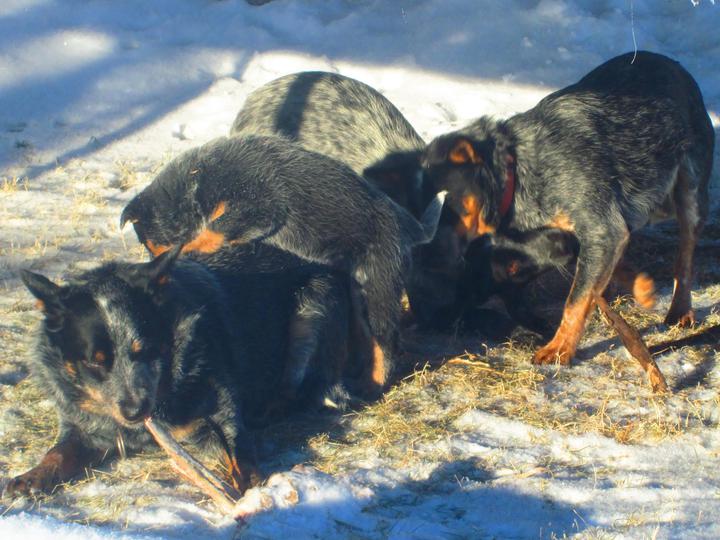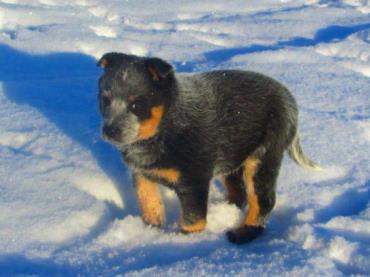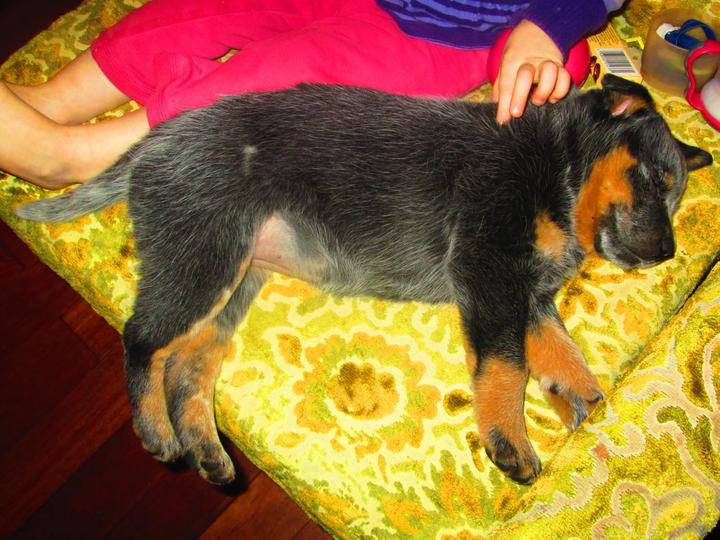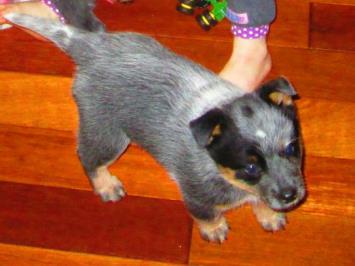 | ||||||
The Puppy’s First year
The first year of your puppy’s life is going to be a lot of fun, happiness, and bring many laughs. The first year is where a lot of changes happen for your growing puppy. This is a relatively short time frame compared to humans who take years to get to adulthood.
Energy
They have lots of energy so a happy pup is a tired pup. Otherwise they will get bored and find trouble to get into. So fetch or run or something like that each day, they will love you for it.
One of several points to keep in mind, is that your puppy is going to chew on some things as all young puppies do. Puppies will be puppies, chewing and digging, but this stage will all pass soon enough.
To help with this you can get them some cheap toys to play with like an old towel for tug-a-war and used stuff toys. You will need to keep a eye on them that they don't shred the toy and eat the pieces this could make them sick.
A bone or two is also nice to have for their young teeth and bones grow strong.
The good part is that you have chosen a blue heeler, an exceptional breed for both short and long term quality. Blue Heelers also make it easy for first time dog owners for training.
When getting this very intelligent Australian Cattle Dog breed, they are very teachable for new things from very early on. For the most part, this is what makes the Blue Heeler so coveted over other dog breeds.
Even though the puppy is quick to learn new tricks and good behaviour, likewise it can be easy to train poor behaviour into them also.
What time you put into them the good you will get out of them.
Free quick training tips & Common questions about your Blue Heeler puppy:
Times change.
An example of old school of what not to dois :
Let’s say, you by chance… kick the pup because they were chasing the bull when they were not told to, they will remember that don't do this. Maybe you think they will work real hard for you then, and of course to please you, they will proceed to grab your prized $20,000 bull by his low hanging fruit with the utmost teeth vigour.
All joking aside, the truth is if you do this, you could injure them and they will probably not want to work for you at all… except when you are not looking.
This will only add salt to your wound to see them work for your wife and kids but not you. So be patient, loving, and most importantly, be consistent. So do yourself a favour, no old school kicking.
Your voice:
The pitch and tone of your voice can have a lot of power. A growl in your voice works well, when needed to bring correction. The puppy remembers this from their mother. Likewise, using a soft voice of praise with some petting on their side when they do well, goes a long way.
How to get my dog to come to me?
Personally, when I need them to come I just whistle a quick, low, short whistle and say “Here.” If you can’t whistle, just yell the pup’s name and a, “HERE, HERE,” this works fine too. It is important to raise your voice so they can hear you when they are working. The key here is, whatever you use just be consistent in tone and word. For a young pup, the leash is a good tool for learning to come. If you have some work for your dog and they don't come back right away but do normally. This tents to be just not doing that job all time, just rust. Just go back to the leash for a bit until they get it again.
The collar and leash:
Start off with a collar on your puppy as soon as you can get one on them. Get a leash so you can keep them close to you for a bit when working with the $20,000 livestock. This is safer for the puppy as well.
Just remember that this is maybe safe for them, but may not be so much for you when they run for safety between your legs from your charging prize bull for the first time. Many Blue Heeler owners do not even use a leash at all and yet get good results. This is true with a really good class example of a Blue Heeler. The leash at times just makes it easier for training some tricks and working tasks.
How to get them to chase?
Most of the time you will not need to train this, they will do this on their own in time. You will more often need the collar and leash to hold them back.
Once they are 3 months old, you can teach them to chase by getting a sheep. Get the sheep or a small calf and pretend to go after the pup like the calf is going to get the pup. The pup may turn tail at first and look back, at this point make that calf look like it is going away from the pup. This should build their confidence, and the pup thinks that they just made the sheep or small calf move away from them.
When do Blue Heeler puppies start working cattle?
Every pup is a bit different, but you should see them starting to work after 3 months old. But it is not uncommon to see them start barking and nipping at cattle as early as 8 -16 weeks old.
We have found that the younger they see a challenging routine, the sooner they learn what you want them to do.
Do they learn better from other dogs?
Yes, if you have a working dog already, that dog will teach them a lot.
Likewise if you have a dog that is not a working dog, it can teach your new pup bad habits. What can also happen is that the Blue Heeler pup will teach the worthless dog some new stuff in time. If you need your pup for working livestock just keep the other dog away while being trained for that bit of time of the day.
As your puppy grows past the first year, you will find a much calmer dog. Past the first year, you should still see your Blue Heeler teachable for new tricks.
Vaccination:
The first vaccination shots (and shot paper work) will have been given when you get a pup from us. As for when the next shots are to be given it is really up to you and your vet to decide what is best for your pup.
Some Vets say one set of shots does the trick, but the next veterinarian may say more shots should be given at nine and twelve weeks. My advise is be safe as one can and give them all shot 3 or do what you think is best. Vaccinations are a great aid to your dog’s heath, but like most things in life they are not always a 100% effective every time.
Pay Back Time:
To have the most effective dog and to get the best results, you will want to have some very specific commands and tricks for your puppy to work on for that first year. While it may take this year or so of work, (being consistent), you will have a very beautiful working dog and companion.
The hard work does pay off in short order with the following 10 to15 years of relatively easy going.
There is more to be said on each one of these training techniques that I may cover in another article in the future. In the mean time, best to you and your Blue Heeler puppy.
Blue Heeler Puppy’s First Year
Weak Ears in Australian Cattle Dogs?
The ears on Australian Cattle Dogs can stand up as soon as 2 months and as late a 1 ½ Years. This can be due to the length and size of the ear.
Longer, larger ears and wider set apart on the head can add to the length of time it can take for them to stand up. If they have shorter ears, they will stand up faster.
Do not play with ears too much like folding the ears backwards and forwards because it looks funny. This will not help the ears to stand up.
So keep an eye on the kids and kid rodeo time with the dog’s ears. Cartilage in the ears can get broke just like in people and this can weaken them.
Fixing the pups ears secret:
There is a little secret breeders use and show dog contenders do to help there dogs ears stand up for the big show.
For the most part this is only to make the dog more showy and is not required.
This is known as temporary taping. As the pup ages, taping is done most times at about 5 - 7 months.
If you have some concern with the chances of your Blue Heelers ears, standing up you can give taping a try.
There are a couple ways of taping but basically taking a piece of surgery tape (so it don’t pull out the hair) and cardboard. And shape it for a standing ear for a little bit of time. Then remove tape and cardboard.
Do this no more than a week at a time then check and rest the ears for a day or two.
Weak ears or just one weak ear can be found in many dog breeds’ genetic line from Dobermans to German Shepherds.
With that all said though, my experience has been that most Red Heelers and Blue genetic lines will stand up at a good rate of 95% of the time with no help at all by the time of 1 year old.



